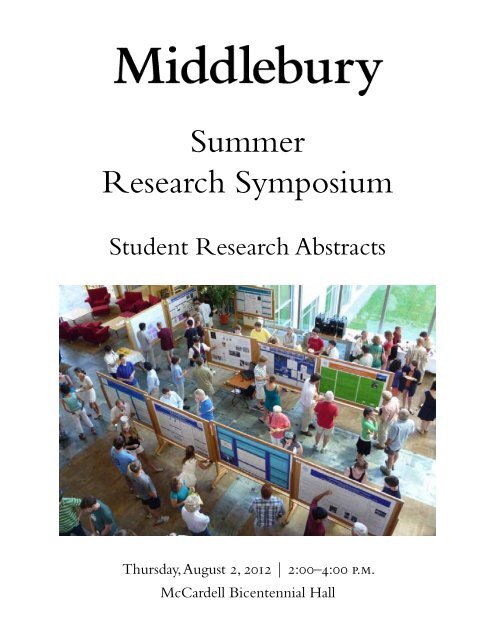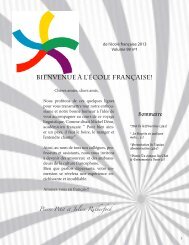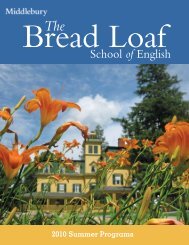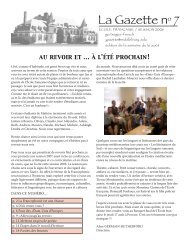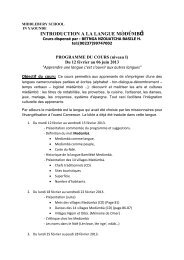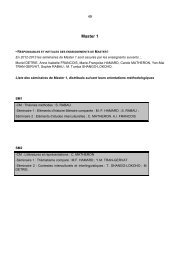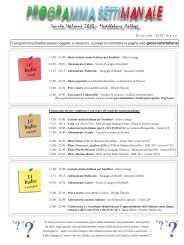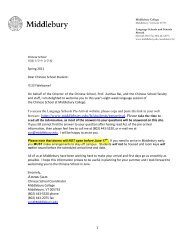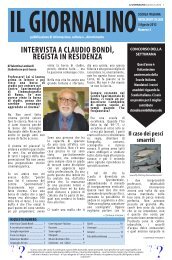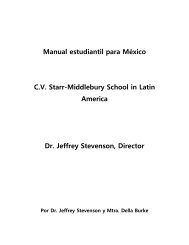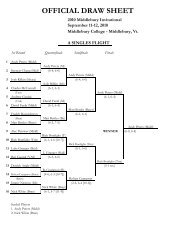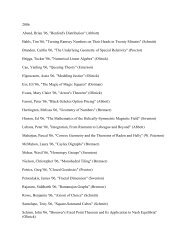2012 Summer Symposium Program - Middlebury College
2012 Summer Symposium Program - Middlebury College
2012 Summer Symposium Program - Middlebury College
Create successful ePaper yourself
Turn your PDF publications into a flip-book with our unique Google optimized e-Paper software.
<strong>Summer</strong><br />
Research <strong>Symposium</strong><br />
Student Research Abstracts<br />
Thursday, August 2, <strong>2012</strong> | 2:00–4:00 p.m.<br />
McCardell Bicentennial Hall
The <strong>Summer</strong> Research <strong>Symposium</strong> is an annual event where students present posters of their<br />
summer research projects for faculty, staff, and other students. It is a great opportunity to<br />
write an abstract, produce a poster and then explain the project to prepare for a professional<br />
conference.<br />
Most of the students are <strong>Summer</strong> Research Assistants who receive stipends to work with a<br />
faculty mentor during the summer. Faculty benefit by having quality research assistance that<br />
can bridge the academic year and span multiple summers. Students benefit from the in-depth<br />
learning that is possible over the focused summer weeks. Research has been shown to be one of<br />
the high impact educational practices that students benefit from most in higher education.<br />
<strong>Summer</strong> assistants are supported by multiple funding sources such as faculty and institutional<br />
grants and <strong>Middlebury</strong> <strong>College</strong> endowments. Funding sources are noted on the left column of<br />
the abstracts.<br />
Statistics at the time of the symposium show over 100 students were <strong>Summer</strong> Research<br />
Assistants in <strong>2012</strong> in the following general departments or programs:<br />
Athletics (1)<br />
Biology (14)<br />
Center for Teaching, Learning and Research (1)<br />
Chemistry (15)<br />
Computer Science (7)<br />
Economics (14)<br />
English & American Literatures (3)<br />
Environmental Studies (3)<br />
Geography (6)<br />
Geology (11)<br />
Music (1)<br />
Philosophy (1)<br />
Physics (7)<br />
Political Science (6)<br />
Psychology (5)<br />
Sociology & Anthropology (1)<br />
Spanish (1)<br />
Students worked an average of 36 hours and 8.5 weeks contributing over 29,000 hours<br />
of research time to the college in the summer of <strong>2012</strong>!<br />
Thank you to all the faculty, staff, and students for all your hard work and enthusiasm.<br />
Undergraduate Research Office<br />
<strong>Middlebury</strong> <strong>College</strong><br />
Bob Cluss, Dean of Curriculum and Faculty Development<br />
Kathy Skubikowski, Director of the Center for Teaching, Learning, and Research<br />
Colleen Norden, Administrative Assistant<br />
go.middlebury.edu/uro
<strong>Middlebury</strong> <strong>Summer</strong> Research <strong>Symposium</strong> <strong>2012</strong><br />
Abstract Title Page<br />
1 Does Context Matter in Lexical Simplification? 4<br />
Patrick Adelstein, Edward Pendergast, and David Kauchak<br />
2 Substrate effect on periphyton composition and abundance in the New Haven River 4<br />
Meg Anderson and Sallie Sheldon<br />
3 Characterizing aquatic macroinvertebrate communities along an elevational gradient in 5<br />
Vermont rivers following tropical storm Irene<br />
Samouel Beguin and Sallie Sheldon<br />
4 Assessing the Source of Uranium and Alpha Radiation in Northwestern Vermont: 5<br />
The Role of Depositional Environment<br />
Kevin Chu and Peter Ryan<br />
5 Identifying Critical Nucleotides for the SloR:SRE Interaction in S. mutans 6<br />
Lou Cornacchione and Grace Spatafora<br />
6 Colonization of Leaf Pack Microhabitats by Macro-invertebrates in the New Haven River 7<br />
Nicholas Dragone and Sallie Sheldon<br />
7 Implications for Low-Temperature Geothermal Resources in Vermont: 8<br />
A Bedrock Mapping and Geochemical Perspective from Northeastern Addison County<br />
Julia Favorito and Peter Ryan<br />
8 Electromagnetic Scattering: Modeling Asymmetric Dielectrics 9<br />
Aden Forrow, Bjorn Kjellstrand and Noah Graham<br />
9 Mutational Analysis of SloR Amino Acid Residues: Finding their Respective Roles in 9<br />
SloR-DNA Binding<br />
Clark Hatheway and Grace Spatafora<br />
10 Attentional Biases to Trauma Relevant Stimuli in Motor Vehicle Accident Survivors 10<br />
and Veterans of the Iraq War: An Eye Tracking Study<br />
Patrick Hebble, Hugh Randall, and Matthew Kimble<br />
11 Manipulating Beam Polarization for Laser Cooling 11<br />
Jacob Hobbie and Anne Goodsell<br />
12 Effects of the Cognitive Interview on Children’s Dietary Recalls 11<br />
Kelsi Morgan, Nora Keathley and Michelle McCauley<br />
Page 1
Page 2<br />
<strong>Middlebury</strong> <strong>Summer</strong> Research <strong>Symposium</strong> <strong>2012</strong><br />
13 Surfactant Modification of Montmorillonite for Environmental Contaminant 12<br />
Remediation<br />
Malcolm Littlefield, Annie Mejaes, and Molly Costanza-Robinson<br />
14 Utilization of Academic Support Services at the Center for Teaching, Learning, 12<br />
and Research<br />
Adrienne Matunas and Yonna McShane<br />
15 Preparing a Proper Environment for Cooling Atoms 13<br />
Poomirat Nawarat and Anne Goodsell<br />
16 3D Capture of Complex Real-World Scenes 14<br />
Nera Nesic, Xi Wang, and Daniel Scharstein<br />
17 An Atlas of Stars Past: Supernova Remnants in the Optical Spectrum 15<br />
Lucia Perez, Teddy Smyth and Frank Winkler<br />
18 Phosphorus Abundance and Reactivity in Champlain Valley Sediments: Implications 16<br />
for Nutrient Transport to Lake Champlain<br />
Lauren Pincus and Peter Ryan<br />
19 Characterization of 4- and 5-coordinate Co(II) Model Complexes by Magnetic 16<br />
Circular Dichroism Spectroscopy<br />
Nathan Rudd and Jim Larrabee<br />
20 Origin of the Moretown Formation, Vermont: A Detrital Zircon Study 17<br />
Juliet Ryan-Davis, Ray Coish, and Will Amidon<br />
21 Comparative MCD study of DapE-Encoded N-Succinyl-l,l-Diaminopimelic Acid 18<br />
Desuccinylase (DapE) from Haemophilus influenza and Neisseria meningitides<br />
Wisath Sae-Lee (Momo) and Jim Larrabee<br />
22 Constructing mutant variants of the S. mutans SloR metalloregulatory protein: 19<br />
A crystal structure on the horizon<br />
Garron Sanchez and Grace Spatafora<br />
23 Mapping Natural Communities for the Nature Conservancy/ Vermont Natural 20<br />
Heritage <strong>Program</strong><br />
Avery Shawler and Bill Hegman<br />
24 The Effect of Metamorphic Grade on Arsenic in Bedrock and Groundwater: 20<br />
An Analysis of Shales, Slates, Phyllites and Schists from the Champlain Valley Sequence<br />
in Quebec and Vermont<br />
Annika Silverman and Peter Ryan
<strong>Middlebury</strong> <strong>Summer</strong> Research <strong>Symposium</strong> <strong>2012</strong><br />
25 The Effect of SloR on Streptococcus mutans susceptibility to chlorhexidine digluconate 21<br />
Meghan Stang and Grace Spatafora<br />
26 Expression and purification of the enzyme methionine aminopeptidase for magnetic 22<br />
circular dichroism and equilibrium dialysis studies<br />
Matthew Thomas Stanley and Jim Larrabee<br />
27 Glycation Inhibits Cytochrome c’s Ability to Induce Apoptosis 23<br />
Karl Wetterhorn, Emily Martine and Roger Sandwick<br />
28 The Production of Molecular Wires through Acyclic Diene Metathesis (ADMET) and 24<br />
Ring Opening Metathesis Polymerization (ROMP) of Chromium Organometallic Arenes<br />
Peter Hetzler, Mark Isbell, Rachel Fowler and Jeff Byers<br />
Page 3
Page 4<br />
1<br />
Patrick Adelstein ‘14<br />
Major: CSCI, MATH<br />
Bicentennial Fund<br />
Edward Pendergast ‘13<br />
Major: CSCI<br />
Bicentennial Fund<br />
David Kauchak<br />
Assistant Professor of Computer<br />
Science<br />
2<br />
Meg Anderson ‘14<br />
Major: BIOL<br />
VT EPSCoR/RACC<br />
Sallie Sheldon<br />
Professor of Biology<br />
<strong>Middlebury</strong> <strong>Summer</strong> Research <strong>Symposium</strong> <strong>2012</strong><br />
Does Context Matter in Lexical Simplification?<br />
Patrick Adelstein, Edward Pendergast, and David Kauchak<br />
Department of Computer Science, <strong>Middlebury</strong> <strong>College</strong>, <strong>Middlebury</strong> VT 05753<br />
Lexical Simplification is the task of replacing a target word or phrase in a sentence<br />
to make the sentence simpler. Lexical simplification is a sub-problem of the full<br />
text simplification problem which can benefit children, second language learners,<br />
and people with cognitive disabilities. In this paper we investigate whether the<br />
textual context surrounding the word to be replaced is important in identifying and<br />
selecting substitutions. Starting with a corpus of sentence-aligned English Wikipedia<br />
and Simple English Wikipedia data we generated lexical simplification examples.<br />
These examples consist of a sentence, a target word to replace, and a list of candidate<br />
substitutes solicited from users on Amazon’s Mechanical Turk service. We compare<br />
data collected both with and without the sentence context and utilize a variety of<br />
metrics including frequency, entropy, and similarity of the collected substitutes. We<br />
find that for some words context does matter for the simplification task, however not<br />
for all words.<br />
Substrate effect on periphyton composition and<br />
abundance in the New Haven River<br />
Meg Anderson and Sallie Sheldon<br />
Department of Biology, <strong>Middlebury</strong> <strong>College</strong>, <strong>Middlebury</strong> VT 05753<br />
This study focused on the relationship between rock size and the algae covering the<br />
rock surface (periphyton). Glass microscope slides were installed in three different<br />
substrate types (sand/gravel, coarse gravel and cobble/boulder) in a small section of<br />
the New Haven River in Bristol, Vermont. Slides were collected over the course<br />
of three weeks to assess species composition, and after three and a half weeks,<br />
periphyton on the cement blocks was dried and weighed. Species composition was<br />
similar between substrate types, and periphyton density increased over time in the<br />
stream. Periphyton abundance was directly related to substrate size with very little<br />
periphyton accruing on cement blocks in sand/gravel. The results from this study<br />
suggest that while the composition of periphyton in streams may not be related<br />
to substrate type, the abundance of periphyton is affected. Further research using<br />
cement blocks and natural substrates will lead to better understanding of which<br />
abiotic factors have the greatest effect on periphyton in streams.
3<br />
Samouel Beguin ‘13<br />
Major: ENVS, Biology<br />
VT EPSCoR<br />
Sallie Sheldon<br />
Professor of Biology<br />
4<br />
Kevin Chu ‘14<br />
Major: ENVS, GEOL<br />
Baldwin/Coney Fund<br />
Peter Ryan<br />
Professor of Geology<br />
<strong>Middlebury</strong> <strong>Summer</strong> Research <strong>Symposium</strong> <strong>2012</strong><br />
Characterizing aquatic macroinvertebrate<br />
communities along an elevational gradient in<br />
Vermont rivers following tropical storm Irene<br />
Samouel Beguin and Sallie Sheldon<br />
Department of Biology, <strong>Middlebury</strong> <strong>College</strong>, <strong>Middlebury</strong> VT 05753<br />
In August 2011, tropical storm Irene struck the Northeastern United States. The<br />
state of Vermont in particular experienced damaging rainfall and flooding. In order<br />
to assess the impact of this large-scale disturbance on Vermont’s river ecosystems,<br />
we studied stream macroinvertebrate communities along an elevational gradient.<br />
Macroinvertebrates were sampled at sites along each river by rubbing stream rocks<br />
smooth and agitating streambed gravel. The number and proportions of different<br />
types of macroinvertebrates were recorded and used to calculate several metrics<br />
describing the composition, taxa richness, and functional feeding groups at each<br />
site. Preliminary results for two rivers in the western region of the state revealed<br />
clear biological gradients corresponding to decreasing elevation, with certain<br />
macroinvertebrate groups found mainly at high elevation sites and others found<br />
mainly at low elevation sites. Several significant relationships were also found<br />
between physical stream characteristics (e.g. canopy cover, dominant substrate type)<br />
and various macroinvertebrate metrics, indicating that physical gradients influence<br />
biological gradients. By combining these results with physical and macroinvertebrate<br />
data from four other Vermont rivers and future Geographic Information Systems<br />
(GIS) analysis, this research will improve understanding of the impacts of both<br />
large-scale disturbance and watershed land use on macroinvertebrate assemblages at a<br />
variety of spatial scales and across a range of storm severity regions.<br />
Assessing the Source of Uranium and Alpha<br />
Radiation in Northwestern Vermont: The Role of<br />
Depositional Environment<br />
Kevin Chu and Peter Ryan<br />
Department of Geology and Environmental Studies, <strong>Middlebury</strong> <strong>College</strong>, <strong>Middlebury</strong> VT 05753<br />
Jonathan Kim, Geologist/Environmental Scientist, Vermont Geologic Survey<br />
From 2000–2002, the Vermont Geological Survey (VGS) found that ~35% of private<br />
wells in Milton and Colchester, VT contain alpha radiation above the VT and EPA<br />
MCL of 15 pCi/L. The source was identified as black chips within the Clarendon<br />
Springs Formation (CSF). Jonathan Kim and colleagues from the VGS speculated<br />
that the black chips were rich in organic material and uranium and hypothesized<br />
that the black chips were evidence for ancient cave collapse breccias; however,<br />
they did not perform geochemical or mineralogical analyses of the black chips.<br />
Page 5
Page 6<br />
5<br />
Lou Cornacchione ‘13<br />
Major: MBBC<br />
Ostro Family Molecular Biology<br />
and Biochemistry Research<br />
Fund<br />
Grace Spatafora<br />
Given Professor of Biology &<br />
Pre-Medical Sciences<br />
<strong>Middlebury</strong> <strong>Summer</strong> Research <strong>Symposium</strong> <strong>2012</strong><br />
Follow-up research in 2011–<strong>2012</strong> by Emily McDonald was prompted by concerns<br />
of citizens in Highgate, VT where the CSF outcrops. Field work consisting of well<br />
and bedrock sampling, followed up with lab analyses, led to the development of<br />
a model in which fluoroapatite incorporates U into its mineral structure on the<br />
ancient seafloor. During marine upwelling, U +4 co-precipitates in place of Ca +2 in<br />
the structure of Ca 5 (PO 4 ) 3 F. It is authigenic but can be re-mobilized by bottom<br />
currents and redeposited as rip-up clasts, possibly explaining the breccias throughout<br />
the CSF. Bedrock samples from Colchester and Milton, VT are being analyzed<br />
using a combination of XRD, SEM-WDS SEM-WDS, ICP-AES, ICP-MS, and<br />
gamma ray spectrometry to interpret geochemistry, mineralogy, and distribution of<br />
breccias and other lithologies in the CSF. Early XRD results have yielded positive<br />
results for fluoroapatite at a site in Colchester where high radioactivity had been<br />
confirmed using gamma ray spectrometry. Fluoroapatite hosts high uranium content<br />
(80-300 ppm) in black chip breccias farther north in Highgate (crustal average<br />
is 3 ppm). Distinctive X-ray diffraction peaks at 0.281, 0.270, 0.244, 0.277, 0.317,<br />
and 0.263 nm provided the positive identification of fluoroapatite. XRD was also<br />
useful in differentiating fluoroapatite in sample 061412-1 and 061412-3 at the highradioactivity<br />
site from chert in sample 061412-14 at Thompson Farm that is not a<br />
source of U. Further analysis will include ICP-AES at <strong>Middlebury</strong> <strong>College</strong>, ICP-MS<br />
at a contract lab (for uranium and thorium content as well as other trace elements),<br />
and SEM-EDS and SEM-WDS for analysis of the micron-scale spatial distribution of<br />
P, U, and other elements.<br />
Identifying Critical Nucleotides for the SloR:SRE<br />
Interaction in S. mutans<br />
Lou Cornacchione and Grace Spatafora<br />
Department of Biology, <strong>Middlebury</strong> <strong>College</strong>, <strong>Middlebury</strong> VT 05753<br />
Streptococcus mutans is considered to be the most cariogenic bacterial species among<br />
those resident in the human oral cavity. S. mutans-induced dental caries have<br />
been implicated in a variety of health risks and are associated with substantial<br />
economic costs. Researchers in the Spatafora laboratory previously demonstrated<br />
that a multitude of virulence genes in S. mutans are regulated by a 25-kDa<br />
metalloregulatory protein called SloR. SloR is known to bind to palindromic<br />
recognition elements (SREs) at promoter-proximal or -distal regions in a<br />
manganese-dependent manner to either repress or activate downstream genes,<br />
respectively. The sloA gene with a promoter-proximal SRE that is repressed in the<br />
presence of elevated manganese concentrations belongs to a sloABC operon, which<br />
encodes an important manganese transporter involved in metal ion homeostasis.<br />
Importantly, a SloR-deficient strain of S. mutans, GMS584, has been demonstrated<br />
to be hyper-cariogenic in a germ-free rat model, and to de-repress virulence<br />
genes in qRT-PCR experiments. The goal of the present study is to further our
6<br />
Nicholas Dragone ‘14<br />
Major: BIOL<br />
Vermont EPSCOR<br />
Sallie Sheldon<br />
Professor of Biology<br />
<strong>Middlebury</strong> <strong>Summer</strong> Research <strong>Symposium</strong> <strong>2012</strong><br />
understanding of the SloR:SRE interaction, by introducing point mutations<br />
into the SRE that precedes the sloABC operon. We based our rationale for SRE<br />
mutagenesis on a probability matrix that we generated previously, and that includes<br />
an interrupted palindrome of 22bp. Specifically, we generated T-to-C transitions<br />
at positions 15, 16, and 19 within the sloA SRE using an OE-PCR and a markerless<br />
mutagenesis approach. In addition, we monitored sloABC expression in both<br />
GMS615 and GMS616, S. mutans strains harboring transitions at SRE positions 15<br />
and 16 respectively, in qRT-PCR experiments. Expression in GMS616 was derepressed<br />
relative to the UA159 wild-type progenitor strain, whereas expression in<br />
GMS615 was not significantly different from that of UA159. These findings implicate<br />
thymidine-16 as important for the SloR:SRE binding and subsequent repression<br />
of the sloABC transcript. Interestingly, previous DNA footprinting experiments<br />
that we performed with SloR revealed an additional region of protection between<br />
two and twelve base pairs upstream of the SRE. To confirm that these upstream<br />
nucleotides are involved in the SloR:SRE interaction, we are targeting eight<br />
additional nucleotides, mainly thymidine residues, for mutation by OE-PCR. Gel<br />
mobility shift experiments are planned with these mutated SRE variants to assess<br />
their relative binding affinities with SloR. The identification of critical nucleotide<br />
bases for SloR binding in this important oral pathogen is significant because it could<br />
inform rational drug design for anti-caries therapeutics.<br />
Colonization of Leaf Pack Microhabitats by<br />
Macro-invertebrates in the New Haven River<br />
Nicholas Dragone and Sallie Sheldon<br />
Department of Biology, <strong>Middlebury</strong> <strong>College</strong>, <strong>Middlebury</strong> VT 05753<br />
Stream Macro-invertebrate communities consist of different guilds based on feeding<br />
behavior. The presence of a guild in a stream microhabitat depends on the food<br />
source available at the site, and the substrate structure. Leaf Packs are an important<br />
stream microhabitat for invertebrates. In this study, artificially created leaf packs were<br />
placed in the field to determine whether invertebrate guilds colonize based on the<br />
presence of the food source, or of the structure the leaves provide. An experiment<br />
using sugar maple leaves, red oak leaves, and plastic leaves, was set out in the New<br />
Haven River. Leaf packs were collected after 1 week, 2 weeks, or 4 weeks, to<br />
determine whether macro-invertebrate colonization and utilization changed as the<br />
leaves broke down. Sugar maple leaves and oak leaves had the highest abundance of<br />
invertebrate while plastic leaves had the lowest abundance. There was no difference<br />
in the presence of guilds among the three leaf treatments although filterers and<br />
gatherers were the most abundant on all three treatments. This result suggests that<br />
leaf packs in streams are primarily used for structure, and not food.<br />
Page 7
Page 8<br />
7<br />
Julia Favorito ‘12<br />
Major: GEOL<br />
Vermont Geological Survey<br />
Peter Ryan<br />
Professor of Geology<br />
<strong>Middlebury</strong> <strong>Summer</strong> Research <strong>Symposium</strong> <strong>2012</strong><br />
Implications for Low-Temperature Geothermal<br />
Resources in Vermont: A Bedrock Mapping and<br />
Geochemical Perspective from Northeastern<br />
Addison County<br />
Julia Favorito and Peter Ryan<br />
Department of Geology, <strong>Middlebury</strong> <strong>College</strong>, <strong>Middlebury</strong> VT 05753<br />
Research into the low-temperature geothermal energy potential in Vermont is<br />
currently being carried out by the Vermont Geological Survey (VGS) in conjunction<br />
with student researchers from <strong>Middlebury</strong> <strong>College</strong> and UVM. Some of the interest<br />
in geothermal potential is based on the discovery of groundwater wells with elevated<br />
uranium and thorium in metasedimentary rocks of the western Green Mountains<br />
as well as granites in central and eastern Vermont. In the vicinity of Bristol and<br />
Starksboro (northeastern Addison County, VT), early Cambrian metasedimentary<br />
rocks of the Pinnacle Formation and Cheshire Quartzite are the target of this<br />
current project. Previous work by the Vermont Geological Survey and <strong>Middlebury</strong><br />
<strong>College</strong> (e.g. theses of Katharine North, 2005; Leland Davis, 2008; Jared Bean,<br />
2009) in Hinesburg indicates that metamorphosed sandstones and mudstones of the<br />
Pinnacle and Fairfield Pond formations as well as the Cheshire Quartzite commonly<br />
contain U and Th which are elevated ~3–5 times above background levels. Although<br />
these elevated levels of U and Th cause issues with water quality, they also may have<br />
a potential benefit in that deep wells may contain water that is warmer than normal<br />
ambient groundwater. This would be caused by radioactive decay of U and Th<br />
and their daughter products. Examining data from the theses cited above indicates<br />
that average water temperature in wells drilled into the metasedimentary rocks is<br />
11.5 o C; by comparison, wells drilled into unmetamorphosed carbonate rocks in<br />
the same area is 10.0 o C. This provides impetus to analyze water temperatures and<br />
bedrock U and Th concentrations in an area (Bristol, Starksboro) where these rocks<br />
are particularly thick and well-exposed. My research to date includes a considerable<br />
amount of field work with Jon Kim of the VGS mapping out fractures and bedrock<br />
in Bristol. Fractures play a major role in the movement of water and bedrock type<br />
likely will strongly control geothermal potential, so both of these factors must be<br />
closely mapped out in order to move ahead with a geothermal project. In addition<br />
to field mapping and fracture analysis, I have also researched types of geothermal<br />
energy systems that might be appropriate for the climate and bedrock types in an<br />
area like Vermont. In th next two weeks I will begin to focus on the chemical<br />
analysis of rock compositions as well as borehole temperature analysis. In my<br />
presentation at the symposium I will be presenting my findings on the possibilities<br />
for geothermal energy in Vermont based on the research and field work I have done<br />
so far this summer.
8<br />
Aden Forrow ‘13<br />
Major: PHYS, MATH<br />
National Science Foundation<br />
(Graham)<br />
Bjorn Kjellstrand ‘13<br />
Major: PHYS<br />
Noah Graham<br />
Associate Professor of Physics<br />
9<br />
Clark Hatheway ‘13<br />
Major: MBBC<br />
NIH <strong>Summer</strong> Research<br />
Fellowship<br />
Grace Spatafora<br />
Given Professor of Biology &<br />
Pre-Medical Sciences<br />
<strong>Middlebury</strong> <strong>Summer</strong> Research <strong>Symposium</strong> <strong>2012</strong><br />
Electromagnetic Scattering: Modeling<br />
Asymmetric Dielectrics<br />
Aden Forrow, Bjorn Kjellstrand and Noah Graham<br />
Department of Physics, <strong>Middlebury</strong> <strong>College</strong>, <strong>Middlebury</strong> VT 05753<br />
What happens when light interacts with an object? The relationship between<br />
the light that went in to the object and the light that comes out gives important<br />
information about the object itself. Knowing the shape of the object and the<br />
differential equations governing electromagnetism should let us calculate this<br />
relationship; the equations, however, are too complicated to solve analytically except<br />
in the simplest cases. We are developing numerical techniques in Mathematica that<br />
do not rely on specific symmetries of the object and are therefore useful in many<br />
more situations.<br />
Mutational Analysis of SloR Amino Acid<br />
Residues: Finding their Respective Roles in<br />
SloR-DNA Binding<br />
Clark Hatheway and Grace Spatafora<br />
Department of Biology, <strong>Middlebury</strong> <strong>College</strong>, <strong>Middlebury</strong> VT 05753<br />
Streptococcus mutans is a gram-positive bacterium normally present along with other<br />
microbes in the microflora of the oral cavity. It plays a principal role in cariogenesis,<br />
as acidic byproducts of its metabolism lower the pH of the plaque environment,<br />
resulting in demineralization of the dental enamel. Of particular interest to the<br />
Spatafora laboratory is a metalloregulatory protein called SloR, which regulates<br />
transcription by binding to short palindromic SloR Recognition Elements (SRE)<br />
present distal or proximal to various genes that have been implicated in S. mutans<br />
virulence. SloR has been shown to repress expression of the sloABC gene cassette,<br />
which codes for an essential manganese ion transport system. SloR does so by<br />
binding to a SRE located upstream of the sloABC genes and proximal to the sloABC<br />
promoter. Previous studies in our laboratory have focused on mutational analysis of<br />
the SloR protein within each of three different functional domains to identify amino<br />
acid residues that are essential for SRE binding. In this study we expanded upon this<br />
work by generating additional mutations in the DNA binding, dimerization, and<br />
FeoA domains. Specifically, we used OE-PCR site-directed mutagenesis to generate<br />
SloR variants with conservative substitutions in sites previously identified to be<br />
important for the SloR-SRE interaction, as well as non-conservative substitutions<br />
in additional sites that we believe are important. We subsequently cloned the<br />
SloR variant amplicons into the pDL277 shuttle vector for transformation into<br />
a SloR-deficient S. mutans strain called GMS182. This strain harbors a fusion of<br />
Page 9
Page 10<br />
10<br />
Patrick Hebble ‘13<br />
Major: NSCI<br />
NIH AREA Grant (R15<br />
MH081276)<br />
Hugh Randall ‘14<br />
Major: PSYC at UVM<br />
NIH AREA Grant (R15<br />
MH081276)<br />
Matthew Kimble<br />
Associate Professor of<br />
Psychology<br />
<strong>Middlebury</strong> <strong>Summer</strong> Research <strong>Symposium</strong> <strong>2012</strong><br />
the sloA promoter to a cat reporter gene within the bacterial chromosome. Future<br />
experiments will assess the putative effect(s) of these mutations on SloR binding<br />
to the promoter-proximal SRE at the sloABC locus. Residues identified as being<br />
important to the SloR-SRE interaction could be potential therapeutic targets.<br />
Treatments could be developed that would interfere with or enhance this interaction<br />
with the aim of controlling S. mutans virulence and cariogenicity.<br />
Attentional Biases to Trauma Relevant Stimuli in<br />
Motor Vehicle Accident Survivors and Veterans of<br />
the Iraq War: An Eye Tracking Study<br />
Patrick Hebble, Hugh Randall, and Matthew Kimble<br />
Department of Psychology, <strong>Middlebury</strong> <strong>College</strong>, <strong>Middlebury</strong> VT 05753<br />
Attentional impairment is one of the symptoms most often associated with posttraumatic<br />
stress disorder (PTSD). Yet, the manifestation of these impairments is<br />
complex and still not completely understood. The DSM-IV lists that both avoidance<br />
of stimuli associated with trauma and hyper-arousal/vigilance are symptoms of<br />
PTSD (APA, 2000). While many studies have used event related potentials to study<br />
these attentional biases in PTSD, relatively few have used eye tracking technology<br />
to do the same. Our research is a follow up to one such study (Kimble et. al., 2010).<br />
In this study a group of veterans of the Iraq war (n=19) were presented with a<br />
series of 20 slides containing two images: one negatively valenced picture and one<br />
neutral. Negatively valenced pictures varied in terms of trauma relevance [Iraq War<br />
vs. Motor Vehicle Accident (MVA) images]. Participants were told to look at the<br />
images as they interested them while their eye movements were being tracked. The<br />
study found that veterans with comparatively higher levels of PTSD symptomology<br />
spent more time looking at the negatively valenced imaged (regardless of trauma<br />
relevance) than participants who reported lower levels of PTSD symptoms. In<br />
addition, the veterans reporting higher levels of PTSD symptoms also tended to look<br />
towards Iraq images first, suggesting that PSTD is associated with hyper-vigilance<br />
rather than avoidant behavior when processing trauma relevant stimuli. In this study,<br />
we collected data from MVA survivors (n=17) using Kimble et al.’s (2010) methods<br />
and compared it to their combat veteran sample. All subjects tended to look first and<br />
longest at negatively valenced images. However, regardless of PTSD levels, veterans<br />
looked at the negative images significantly longer than the MVA survivors. Veterans<br />
also looked at the negative images first significantly more than the MVA survivors<br />
regardless of PTSD symptoms. Finally, while not statistically significant, veterans<br />
looked at trauma relevant images longer than MVA survivors. These findings suggest<br />
that trauma type plays a key role in post-traumatic pathology, and that the levels of<br />
vigilance and avoidance in persons with PTSD may be dependent on the type of<br />
trauma one experienced.
11<br />
Jacob Hobbie ‘15<br />
Major: PHYS<br />
Elizabeth Miller Palen ‘40 Fund<br />
Anne Goodsell<br />
Assistant Professor of Physics<br />
12<br />
Kelsi Morgan ‘14<br />
Major: LITS<br />
Vermont Genetics Network<br />
Michelle McCauley<br />
Professor of Psychology<br />
<strong>Middlebury</strong> <strong>Summer</strong> Research <strong>Symposium</strong> <strong>2012</strong><br />
Manipulating Beam Polarization for Laser<br />
Cooling<br />
Jacob Hobbie and Anne Goodsell<br />
Department of Physics, <strong>Middlebury</strong> <strong>College</strong>, <strong>Middlebury</strong> VT 05753<br />
In the Goodsell lab, we are constructing an apparatus to trap and laser cool<br />
Rubidium atoms. To perform this, we are using a laser that is tuned to emit light at<br />
a precise frequency. Using mirrors to direct the path of the beam, we send our laser<br />
through various pieces of optical equipment, each with a specific function. Devices<br />
such as lenses allow us to reshape the laser beam, while others such as wave plates<br />
allow us to alter the polarization, or the orientation of the oscillations of the light<br />
wave. The polarization of light is crucial for the central part of our experiment:<br />
laser cooling of atoms. Light that is polarized circularly, that is to say the orientation<br />
of the oscillations rotates as the light travels, is used to cool and trap atoms inside a<br />
vacuum chamber and hold them in a very small region. With three intersecting laser<br />
beams, atoms are prevented from escaping in any direction. Laser cooled atoms are<br />
particularly useful to perform experiments on because they have minimal initial<br />
velocity. When we entered the lab this summer, the laser only passed through several<br />
optical components on a small section of the table. Currently, the laser is split into<br />
three beams that now pass through the vacuum chamber which we assembled. We<br />
also installed a second “repump” laser that will perform a slightly different function<br />
from the original laser. This also required installing many of the optical components<br />
also placed in the path of the first laser.<br />
Effects of the Cognitive Interview on Children’s<br />
Dietary Recalls<br />
Kelsi Morgan, Nora Keathley and Michelle McCauley<br />
Department of Psychology, <strong>Middlebury</strong> <strong>College</strong>, <strong>Middlebury</strong> VT 05753<br />
This study examined whether children interviewed with the Enhanced Cognitive<br />
Interview (ECI) would perform better on a dietary recall task compared to those<br />
interviewed with the multiple-pass protocol (MPP), and if so, which type(s) of<br />
fact recall the ECI improves, and where in the interview these facts are found.<br />
Fifty-seven children (average age 7 years) participated in an after-school event that<br />
involved eating snacks. After an average two-day delay, the children were asked to<br />
recall the foods they had seen and eaten at the event with either the ECI or MPP.<br />
The ECI allowed for a higher recall of overall facts without compromising accuracy.<br />
The findings also show an increase in accurate fact recall with the ECI without an<br />
increase in inaccurate or intrusive information. The study also found that these facts<br />
are not evenly distributed throughout the interview: by splitting each interview’s<br />
Page 11
Page 12<br />
13<br />
Malcolm Littlefield ‘13<br />
Major: ENVS, CHEM<br />
National Science Foundation<br />
(Costanza-Robinson)<br />
Annie Mejaes ‘13<br />
Major: ENVS, CHEM<br />
National Science Foundation<br />
(Costanza-Robinson)<br />
Molly Costanza-Robinson<br />
Associate Professor of<br />
Chemistry and Environmental<br />
Studies<br />
14<br />
Adrienne Matunas ‘13<br />
Major: RELI, PHIL<br />
Undergraduate Collaborative<br />
Research Fund<br />
Yonna McShane<br />
Director of Learning Resources<br />
for CTLR<br />
<strong>Middlebury</strong> <strong>Summer</strong> Research <strong>Symposium</strong> <strong>2012</strong><br />
substantive section into thirds, we found that accurate, inaccurate, intrusive facts<br />
occur in differing patterns by time, as does the proportion of accurate facts for each<br />
interview. These findings have important implications for health professionals who<br />
interview children.<br />
Surfactant Modification of Montmorillonite for<br />
Environmental Contaminant Remediation<br />
Malcolm Littlefield, Annie Mejaes, and Molly Costanza-Robinson<br />
Department of Chemistry & Biochemistry, <strong>Middlebury</strong> <strong>College</strong>, <strong>Middlebury</strong> VT 05753<br />
Surfactant-modified clay minerals (organoclays) are increasingly being examined<br />
as a cost-effective, sorbent for environmental contaminants (e.g., for groundwater<br />
remediation). However, few studies have examined the relationship between the<br />
microstructure and chemistry of the organoclay and its capacity to adsorb various<br />
contaminants. Our work this summer involved preparing and characterizing<br />
a Na-montmorillonite that we modified with the cationic surfactant myristyl<br />
trimethylammonium bromide. The organomontmorillonite was prepared at various<br />
surfactant surface coverages (% of cation exchange capacity, CEC). X-ray diffraction<br />
revealed the basal spacing of 100 % CEC montmorillonite to be 17.8 Å, significantly<br />
larger than that for unmodified montmorillonite (12.5 Å). An expanded basal spacing<br />
may increase the clay’s adsorption capacity for larger contaminants. No uptake of<br />
aniline, a model contaminant, was observed for unmodified montorillonite, whereas<br />
1.2 mg/g of aniline was adsorbed by the 100% CEC modified montorillonite. We<br />
attribute these findings to the increased hydrophobicity of the modified clay surface,<br />
as well as the increased basal spacing. These preliminary findings, along with<br />
additional data, will greatly increase our ability to optimize clays for contaminant<br />
uptake.<br />
Utilization of Academic Support Services at the Center for Teaching,<br />
Learning, and Research<br />
Adrienne Matunas and Yonna McShane<br />
Center for Teaching, Learning, and Research, <strong>Middlebury</strong> <strong>College</strong>, <strong>Middlebury</strong> VT 05753<br />
The Center for Teaching, Learning, and Research offers an array of academic<br />
support services to <strong>Middlebury</strong> students, including peer and professional tutoring<br />
in writing, quantitative disciplines, languages, oral presentation skills, study skills,<br />
and time management. Literature reviews about postsecondary academic support<br />
reveal the widespread belief that learning centers at 4-year institutions serve a<br />
small segment of the student body, predominantly first-year students and students<br />
experiencing academic crises. At institutions like <strong>Middlebury</strong> where student<br />
achievement is very high, it is often assumed that few students seek tutoring, or that
15<br />
Poomirat Nawarat ‘14<br />
Major: PHYS, CSCI<br />
Bicentennial Fund<br />
Anne Goodsell<br />
Assistant Professor of Physics<br />
<strong>Middlebury</strong> <strong>Summer</strong> Research <strong>Symposium</strong> <strong>2012</strong><br />
only first-year students or students with serious academic needs utilize academic<br />
support services. Data collected from AccuTrack, the CTLR’s tutoring database,<br />
challenge these assumptions. Over 44% of the <strong>Middlebury</strong> student body met with a<br />
CTLR tutor over the course of the 2011–<strong>2012</strong> academic year, and more than half of<br />
visits to professional tutors, peer content tutors, and peer writing tutors were made<br />
by sophomore, junior, and senior students. In addition, many of the students who<br />
met with tutors had high grade point averages, up to and including 4.0. Continued<br />
research will focus on academic outcomes for students who took advantage of<br />
CTLR services in order to understand more precisely the impact of tutoring and<br />
academic support on student achievement at <strong>Middlebury</strong>.<br />
Preparing a Proper Environment for Cooling<br />
Atoms<br />
Poomirat Nawarat and Anne Goodsell<br />
Department of Physics, <strong>Middlebury</strong> <strong>College</strong>, <strong>Middlebury</strong> VT 05753<br />
The ultimate goal of our project is to perform laser cooling on a dilute gas of neutral<br />
atoms, which is Rubidium in our case. In order to achieve this goal one needs to<br />
construct a proper integrated system from smaller systems that function in many<br />
different tasks needed in the cooling process. We need lasers for cooling the dilute<br />
gas. We need a proper optical system to manipulate the laser beams. We need a<br />
vacuum chamber to keep the gas dilute in low temperature. We need a pump system<br />
to create and maintain the proper low-pressure environment within the chamber.<br />
We need a magnetic-field system to confine the cold atoms in a finite space. For our<br />
experiment all these component systems need to work well together in one complex<br />
system of cooling, like many pieces of a jig-saw puzzle are required for a complete<br />
picture. In the beginning of summer we already had most of the equipment,<br />
however we only had one laser and some part of optical system that had been set<br />
up and ready to use. My tasks are setting up two extra lasers, vacuum chamber and<br />
ion pump, and also helping in optical alignment. Now we already have a proper<br />
arrangement of the vacuum chamber and ion pump system that can maintain the<br />
pressure at 1.0x10 -10 Torr. We can also manipulate the three pairs of laser beams to<br />
cross each other in the middle of the chamber in the simple Cartesian configuration.<br />
Page 13
Page 14<br />
16<br />
Nera Nesic ‘13<br />
Major: CSCI<br />
NSF Grant IIS-0917109<br />
(Scharstein)<br />
Xi Wang ‘14<br />
Major: CSCI, ECON<br />
NSF Grant IIS-0917109<br />
(Scharstein)<br />
Daniel Scharstein<br />
Professor of Computer Science<br />
<strong>Middlebury</strong> <strong>Summer</strong> Research <strong>Symposium</strong> <strong>2012</strong><br />
3D Capture of Complex Real-World Scenes<br />
Nera Nesic, Xi Wang, and Daniel Scharstein<br />
Department of Computer Science, <strong>Middlebury</strong> <strong>College</strong>, <strong>Middlebury</strong> VT 05753<br />
The goal of this project is to create new datasets and benchmarks for 3D<br />
reconstruction methods. <strong>Middlebury</strong> hosts an internationally-known benchmark<br />
for stereo algorithms, which compute 3D depth maps from multiple input images.<br />
Existing test datasets, however, do not exhibit real-world challenges such as<br />
complex occlusion, large depth ranges, and specular objects. Building on work<br />
done in previous summers, we used a mobile stereo rig with four cameras and<br />
structured lighting from two video projectors to capture images and accurate 3D<br />
scene structure. We acquired 7 new datasets of different scenes, each under multiple<br />
lighting conditions and exposures. Our new datasets include a reconstruction of the<br />
famous Tsukuba “head and lamp” scene as well as a motorcycle scene in which we<br />
applied matte white paint to glossy surfaces in order to enable 3D measurements. We<br />
also improved both hardware and software of our system for increased robustness,<br />
accuracy, and usability. Finally, we created scripts for automatic generation of<br />
extensive webpages organizing and visualizing our results.
17<br />
Lucia Perez ‘14<br />
Major: Astrophysics at<br />
Wellesley<br />
National Science Foundation<br />
(Winkler)<br />
Teddy Smyth ‘15<br />
Major: Undeclared<br />
National Science Foundation<br />
(Winkler)<br />
Frank Winkler<br />
Professor of Physics<br />
<strong>Middlebury</strong> <strong>Summer</strong> Research <strong>Symposium</strong> <strong>2012</strong><br />
An Atlas of Stars Past: Supernova Remnants in<br />
the Optical Spectrum<br />
Lucia Perez, Teddy Smyth and Frank Winkler<br />
Department of Physics, <strong>Middlebury</strong> <strong>College</strong>, <strong>Middlebury</strong> VT 05753<br />
Supernova remnants are the luminous shells of gas produced by the explosive<br />
deaths of large stars. They reveal the composition of stars and contribute to our<br />
understanding of star life cycles, the evolution of galaxies, and the formation<br />
of planets. In our work, we processed multiple narrow-band image datasets of<br />
supernova remnants (SNRs) taken by Prof. Frank Winkler at the 0.9m CTIO<br />
Schmidt Telescope at the Observatorio Interamericano de Cerro Tololo in Chile<br />
and the 0.9m Schmidt telescope at Kitt Peak National Observatory in Arizona.<br />
These optical images of thirteen SNRs were taken through filters revealing<br />
hydrogen-alpha, [sulfur II], and [oxygen III] emission lines and the red and green<br />
continuums. Using IRAF, we converted the raw data into images ready for analysis<br />
and presentation. First, we corrected many systematic imperfections in the raw<br />
images caused by effects of the charged-coupled device (CCD). We then set each<br />
image’s world coordinate system, combined multiple exposures into a single frame,<br />
and subtracted a color continuum frame to reveal the discrete gas emissions of the<br />
SNRs. Frames in each wavelength were corrected to standardize flux, allowing for<br />
direct comparison of the gas emissions through measurements of the integrated flux.<br />
Using our images, we began creating an online atlas to serve as a resource for the<br />
greater astronomy community. Astronomers will be able to access scientific-grade<br />
narrow-band optical images<br />
primed for significant<br />
research use. Also included<br />
in our atlas are images of<br />
the SNRs from the WISE<br />
and 2MASS all-sky infrared<br />
surveys and Chandra X-ray<br />
observations, allowing<br />
for side-by-side emission<br />
comparison. We will<br />
continue making images<br />
from more SNRs available,<br />
expanding the atlas to<br />
encompass as many SNRs<br />
as possible.<br />
Combined false-color image of the supernova remnant IC 443 (Jellyfish Nebula)<br />
with stars subtracted away.<br />
Page 15
Page 16<br />
18<br />
Lauren Pincus ‘14<br />
Major: CHEM, GEOL<br />
Gretchen Augat Reilly ‘60<br />
Environmental Studies Fund<br />
Peter Ryan<br />
Professor of Geology<br />
19<br />
Nathan Rudd ‘13<br />
Major: CHEM<br />
National Science Foundation<br />
(Larrabee)<br />
Jim Larrabee<br />
William R. Kenan Jr. Professor<br />
of Chemistry<br />
<strong>Middlebury</strong> <strong>Summer</strong> Research <strong>Symposium</strong> <strong>2012</strong><br />
Phosphorus Abundance and Reactivity in<br />
Champlain Valley Sediments: Implications for<br />
Nutrient Transport to Lake Champlain<br />
Lauren Pincus and Peter Ryan<br />
Department of Geology, <strong>Middlebury</strong> <strong>College</strong>, <strong>Middlebury</strong> VT 05753<br />
Phosphorus is the main limiting nutrient responsible for eutrophication and toxic<br />
algal blooms in Lake Champlain, and in order to model P transport from the<br />
basin to the lake, a better understanding of P concentrations across the basin is<br />
necessary. Research and modeling efforts thus far have mainly focused on the<br />
release of phosphorus from point sources such as sewage treatment plants and from<br />
agricultural non-point sources; however, data is needed on P release from natural<br />
sources, especially eroding stream beds and lake shore deposits in order to accurately<br />
model the transport of P to Lake Champlain. This project seeks to collect data on<br />
P abundance in non-point sources such as river floodplains, eroding cut banks, and<br />
forest soils. Soil, sand, and clay samples have been collected at sites along multiple<br />
tributaries to the southern and central parts of Lake Champlain. X-ray diffraction<br />
was used to understand the mineralogical composition of collected samples. Relative<br />
amounts of the minerals were measured with particular importance placed on<br />
minerals with the potential to adsorb P such as smectite and iron hydroxides. This<br />
data provides insight into which minerals are present in clays, sands, and soils to<br />
release phosphorus or hold it in an insoluble form. Comparisons between weathered<br />
and unweathered samples can also potentially indicate which minerals may be<br />
preferentially weathering to release phosphorus. Research will continue with<br />
measurements of total P using LiBO 2 fusion and ICP-AES analysis of the samples.<br />
Additionally available P will be extracted and measured using sodium bicarbonate or<br />
another extractant.<br />
Characterization of 4- and 5-coordinate<br />
Co(II) Model Complexes by Magnetic Circular<br />
Dichroism Spectroscopy<br />
Nathan Rudd and Jim Larrabee<br />
Department of Chemistry & Biochemistry, <strong>Middlebury</strong> <strong>College</strong>, <strong>Middlebury</strong> VT 05753<br />
The determination of zero-field splitting (ZFS) parameters provides valuable<br />
insight into the geometric and electronic structure of metalloenzyme active sites.<br />
Variable-temperature, variable-field magnetic circular dichroism (VTVH MCD)<br />
sheds light on the phenomenon of ground-state zero-field splitting, as well as a basis<br />
for investigating paramagnetic metal-containing enzyme active sites to see how<br />
structure correlates with mechanisms. VTVH MCD spectroscopy has been applied
20<br />
Juliet Ryan-Davis ‘13<br />
Major: GEOL<br />
John M. White ‘52 Memorial<br />
Fund and Northeastern GSA<br />
Undergraduate Research Grant<br />
Ray Coish<br />
Robert R. Churchill Professor of<br />
Geosciences<br />
Will Amidon<br />
Assistant Professor of Geology<br />
<strong>Middlebury</strong> <strong>Summer</strong> Research <strong>Symposium</strong> <strong>2012</strong><br />
to eight mononuclear, high spin (S=3/2) Co(II) model complexes with coordination<br />
numbers of four or five. These complexes vary with skeletal structure and bound<br />
ligands. VTVH MCD has been used to investigate the ground state electronic<br />
structure of each species. The MCD spectra for the four-coordinate complexes<br />
have positive and negative transition bands between 500-750 nm, while the fivecoordinate<br />
Co(Et 4 dien)Cl 2 complex spectrum has bands between the larger range<br />
of 200–900 nm. Axial (D) and rhombic (E) zero-field splitting values—as well as<br />
spin Hamiltonian parameters—are determined computationally through a Fortranbased<br />
fitting program. Analysis of only the complex Co(L1)N 3 [L1: HB(3-tertbutylpyrazole)<br />
3 ] is finished to date (average D and E values of 8.6188 and 0.1872 cm -1 ,<br />
respectively). Future work will include fitting for the additional model complexes,<br />
as well as elucidating connections between computational parameters and enzyme<br />
active site structure and function.<br />
Origin of the Moretown Formation, Vermont:<br />
A Detrital Zircon Study<br />
Juliet Ryan-Davis, Ray Coish, and Will Amidon<br />
Department of Geology, <strong>Middlebury</strong> <strong>College</strong>, <strong>Middlebury</strong> VT 05753<br />
Vermont’s geology reveals a series of collisional and rifting events, evidence for<br />
which is preserved in the various geologic belts. Detailed studies of these belts<br />
provide insight into the complex history of the northeastern Appalachian Mountains.<br />
U-Pb age analysis of detrital zircons from the Moretown Formation, part of the<br />
Rowe-Hawley belt, Vermont, will be used to determine the age of deposition of the<br />
formation and constrain its sedimentary provenance. The formation, mainly quartzrich<br />
granofels, phyllite and quartzite, with minor volcanogenic material as well as<br />
regions of greenstone and other metamorphosed mafic rocks, is currently interpreted<br />
to have been deposited in an arc-trench gap, likely a forearc basin, between the<br />
> 900 Ma Laurentian continental rocks and the approaching Shelburne Falls Arc,<br />
active between ~485 and 460 Ma. That arc is preserved in the highly deformed<br />
Barnard Volcanic unit in Vermont, which extends southward into the Hawley<br />
Formation in Massachusetts. In constraining the age of the sedimentary source of the<br />
Moretown Formation, we will determine whether it was formed by erosion of the<br />
young Shelburne Falls volcanic arc, or from older Laurentian continental material.<br />
Seven samples, 25 or more kilograms each, were collected from the Montpelier<br />
quadrangle, three quartzites and two phyllites from the Dumpling Hill belt, and two<br />
quartzites from the Wrightsville belt. Zircons were extracted from those samples<br />
using standard mineral separation procedures. Roughly 20 kilograms of rock was<br />
crushed using a large jaw crusher, and sifted into several size components, of which<br />
the finest grain size, less than 208 nm, was used. Samples were rinsed and panned<br />
in a standard gold pan to separate rock powder and fine sheet minerals from the<br />
sample. The sample was run through a Frantz magnetic separator up to 1.2 amps to<br />
Page 17
Page 18<br />
21<br />
Wisath Sae-Lee (Momo) ‘13<br />
Major: BIOCHEM<br />
National Science Foundation<br />
(Larrabee)<br />
Jim Larrabee<br />
William R. Kenan Jr. Professor<br />
of Chemistry<br />
<strong>Middlebury</strong> <strong>Summer</strong> Research <strong>Symposium</strong> <strong>2012</strong><br />
separate magnetic minerals. The remaining non-magnetic fraction was run through<br />
heavy liquid separation, using Methylene Iodide which has a density of 3.3 g/cm 3<br />
to collect minerals that were higher in density—zircon has a density of ~4.6 g/cm 3 .<br />
Pyrite also has a higher density, close to 5 g/cm 3 , and so some samples were reacted<br />
in strong hydrofluoric acid baths to dissolve minerals other than zircons. Collected<br />
zircons were then mounted in epoxy and polished for use in the scanning electron<br />
microscope (SEM) and, later in the summer, the electron microprobe (EMP) at RPI<br />
in Troy, NY for cathodoluminescence (CL) imaging. The laser ablation inductively<br />
coupled plasma mass spectrometer (LA-ICP-MS) at RPI will be used to date a<br />
random selection of ~80 detrital grains from each sample, by comparing the ratios<br />
of uranium and lead isotopes to a standard. Geochemical and petrographic data for<br />
each sample will be found using the ICAP spectrometer at <strong>Middlebury</strong> and by thin<br />
section analysis. Further sampling and analysis farther north in the Craftsbury area<br />
may provide insight into variability along the length of the formation.<br />
Comparative MCD study of DapE-Encoded<br />
N-Succinyl-l,l-Diaminopimelic Acid<br />
Desuccinylase (DapE) from Haemophilus influenza<br />
and Neisseria meningitides<br />
Wisath Sae-Lee (Momo) and Jim Larrabee<br />
Department of Chemistry and Biochemistry, <strong>Middlebury</strong> <strong>College</strong>, <strong>Middlebury</strong> VT 05753<br />
DapE-Encoded N-Succinyl-l,l-Diaminopimelic Acid Desuccinylase (DapE) plays<br />
an integral role in the biosynthesis of lysine (Lys) and meso-diaminopimelic acid<br />
(mDAP). These biosynthetic processes provide essential components for both<br />
protein synthesis and the construction of peptidoglycan in the bacterial cell wall.<br />
Previous gene knock-out studies showed that the deletion of DapE gene induced<br />
lethality even in lysine-supplemented media, suggesting that lysine cannot be<br />
imported by other pathways. Since the lysine biosynthetic pathway is distinctive<br />
to most gram-negative and some gram-positive bacteria, inhibitors of DapE could<br />
provide selective bacterial toxicity. In this work, DapEs from Haemophilus influenza<br />
(HiDapE) and Neisseria meningitides (NmDapE) were studied with various equivalents<br />
of Co(II) with and without two different inhibitors—Caprtopril and Dithiothreitol<br />
(DTT)—using magnetic circular dichroism (MCD). The result from the study of<br />
the DapEs with Co(II) showed the electronic geometry of the two binding sites to<br />
be 4- and 6-coordinate which have not been found in any other metalloenzymes.<br />
The affinities of both sites in NmDapE appeared to be the same while the affinity of<br />
the 4-coordinate site was higher than the 6-coordinate site for HiDapE. The MCD<br />
spectra showed both inhibitors to be antiferromagnetically couple with the two<br />
metals through a sulfide bridge.
22<br />
Garron Sanchez ‘13<br />
Major: MBB<br />
National Institutes of Health<br />
(Spatafora)<br />
Grace Spatafora<br />
Given Professor of Biology &<br />
Pre-Medical Sciences<br />
<strong>Middlebury</strong> <strong>Summer</strong> Research <strong>Symposium</strong> <strong>2012</strong><br />
Constructing mutant variants of the S. mutans<br />
SloR metalloregulatory protein: A crystal<br />
structure on the horizon<br />
Garron Sanchez and Grace Spatafora<br />
Department of Biology, <strong>Middlebury</strong> <strong>College</strong>, <strong>Middlebury</strong> VT 05753<br />
Streptococcus mutans, the primary causative agent of dental caries in humans, regulates<br />
multiple virulence genes with its 25kD SloR metalloregulatory protein. The present<br />
study sets out to elucidate the interaction of SloR with its SloR Recognition DNA<br />
Binding Element (SRE) via a site-directed mutagenesis approach. We recently<br />
obtained plasmid pAG from Dr. Arthur Glasfeld at Reed <strong>College</strong> that harbors<br />
the 654bp sloR coding sequence immediately downstream of a T7 promoter, a<br />
poly-histidine tag and a small ubiquitin-related modifier (SUMO). We will use<br />
this plasmid and the QuikChange II Site directed mutagenesis kit (Stratagene) to<br />
generate site-specific mutations in the N-terminal DNA binding domain, the central<br />
dimerization domain, and the C-terminal FeoA domain of the SloR protein. The<br />
mutations will be confirmed by nucleotide sequencing and the pAG-derivative<br />
constructs used to transform<br />
E. coli BL21 for subsequent<br />
IPTG induction and protein<br />
expression. The resulting SloR<br />
mutant variants will be purified<br />
from E. coli cell lysates and<br />
culture supernatants by cobalt<br />
column chromatography.<br />
The fusion proteins will<br />
be cleaved with a SUMOspecific<br />
protease (Ulp1) to<br />
generate sufficient quantities<br />
of native SloR for subsequent<br />
X-ray crystallography. In<br />
collaboration with Dr.<br />
Glasfeld we will crystallize<br />
the SloR variants under a<br />
variety of different conditions,<br />
including in the presence of<br />
the 22bp SRE and in various<br />
concentrations of manganese.<br />
In this way we will be able to identify the impact that specific amino acids have on<br />
SloR-SRE binding, metal ion coordination, and protein dimerization, all of which<br />
are likely paramount for SloR-mediated virulence gene expression. This work is<br />
especially significant because it can reveal amino acid residues for targeting with a<br />
mimetic and so foster rational drug design aimed at alleviating caries.<br />
Page 19
Page 20<br />
23<br />
Avery Shawler ‘13<br />
Major: ENVS, BIOL<br />
Bob Churchill Fund<br />
Bill Hegman<br />
GIS Specialist<br />
24<br />
Annika Silverman ‘13<br />
Major: ENVS, GEOL<br />
Gretchen Augat Reilly ‘60<br />
Environmental Studies Fund<br />
Peter Ryan<br />
Professor of Geology<br />
<strong>Middlebury</strong> <strong>Summer</strong> Research <strong>Symposium</strong> <strong>2012</strong><br />
Mapping Natural Communities for the Nature<br />
Conservancy/ Vermont Natural Heritage<br />
<strong>Program</strong><br />
Avery Shawler and Bill Hegman<br />
Department of Geography, <strong>Middlebury</strong> <strong>College</strong>, <strong>Middlebury</strong> VT 05753<br />
This summer I’m mapping natural communities for the Vermont Natural Heritage<br />
<strong>Program</strong>. A natural community is an interacting assemblage of organisms, their<br />
physical environment, and the natural processes that affect them. Identifying<br />
natural communities helps ecologists understand how species interact with each<br />
other and their physical environment. Classifying natural communities is important<br />
for conservation, land management and land use planning. The Vermont Natural<br />
Heritage <strong>Program</strong> has been working on mapping natural communities owned by<br />
The Nature Conservancy. I’ve just finished mapping the High Pond Preserve in<br />
Brandon, VT. Using a preliminary map created by Eric Sorenson, his field notes and<br />
aerial photography I’ve been creating a final map. I’ve worked in the field identifying<br />
species and natural communities and also in the GIS lab mapping out the natural<br />
communities. The next site that I’m mapping is the LaPlatte River delta.<br />
The Effect of Metamorphic Grade on Arsenic in<br />
Bedrock and Groundwater: An Analysis of Shales,<br />
Slates, Phyllites and Schists from the Champlain<br />
Valley Sequence in Quebec and Vermont<br />
Annika Silverman and Peter Ryan<br />
Department of Geology, <strong>Middlebury</strong> <strong>College</strong>, <strong>Middlebury</strong> VT 05753<br />
Recent research in Vermont (e.g. Ali Thompson thesis of 2011, Diego Russell thesis<br />
of <strong>2012</strong>) and previous work in the Himalayas (Hattori et al 2005) and California<br />
(Bebout et al 1999) suggests that the concentration of arsenic (As) in shales<br />
decreases as they are heated and compressed by metamorphism into slates, phyllites<br />
and eventually schists. This clearly has potential implications for predicting the<br />
occurrence of arsenic in groundwater. In the Taconic region of Vermont, low-grade<br />
slates contain an average of 44 mg/kg As and 33% of bedrock water wells contain<br />
>10 mg/L (ppb) As, the EPA maximum contaminant level for drinking water.<br />
By comparison, higher-grade phyllites and schists from other areas of Vermont<br />
contain an average of 3.5 ppm As and only 4% of wells contain >10 ppb As. Thus, it<br />
appears that the rocks of Vermont contain evidence for the control of metamorphic<br />
grade on arsenic in groundwater—the higher the grade of metamorphism, the less<br />
naturally-occurring As in rock and in well water. In order to minimize variability
25<br />
Meghan Stang ‘13<br />
Major: MBBC<br />
NIH <strong>Summer</strong> Research Fellow<br />
Grace Spatafora<br />
Given Professor of Biology &<br />
Pre-Medical Sciences<br />
<strong>Middlebury</strong> <strong>Summer</strong> Research <strong>Symposium</strong> <strong>2012</strong><br />
in initial rock composition, sedimentary and metamorphic rocks the Connecticut<br />
Valley Sequence (CVS) were sampled. The CVS rocks are of similar age (Siluro-<br />
Devonian) and were deposited in a basin off the astern margin of North America.<br />
In Vermont, the CVS is highly metamorphosed (to zones that range from biotite<br />
grade to garnet and staurolite), and the incidence of elevated As in wells in this part<br />
of Vermont is very low (only one well out of 41 contains > 10 ppb As); conversely,<br />
in the Lac Megantic region of Quebec, the CVS is effectively still sedimentary rock<br />
(at most, it is metamorphosed to chlorite zone), and the Quebec Ministry of Health<br />
reports numerous wells that exceed 10 ppb As. Given that the CVS was deposited<br />
in the same Siluro-Devonian basin off the eastern margin of North America,<br />
this project provides the chance to examine the effect of metamorphic grade on<br />
As within a single rock sequence. Thus, this phase of the study seeks to test the<br />
hypothesis that high-grade rocks in Vermont will contain very low concentrations<br />
of As (preliminary analysis indicates that they contain an average of 3.5 mg/kg)<br />
relative to stratigraphically-equivalent unmetamorphosed shales from Quebec,<br />
which are expected to contain > 20 ppm As on average. Field work was conducted<br />
in late June in southeastern Quebec with Denis Lavoie of the Geological Survey<br />
of Canada and Jonathan Kim of the Vermont Geological Survey to examine the<br />
Quebec rocks of the CVS. Samples were obtained from several formations that<br />
outcropped near the town of Saint-George—most notably the Compton Formation,<br />
which is the lithological equivalent of the Gile Mountain Formation in Vermont.<br />
Samples are currently undergoing analysis by inductively coupled plasma-atomic<br />
emission spectrometry (ICP-AES) in the Geology Department as well as by ICPmass<br />
spectrometry (ICP-MS) at an independent lab (for As, in particular). Emerging<br />
geochemical data from this sequence of shales, slates, phyllites and schists from<br />
the CVS is expected to help further constrain the role of metamorphism on the<br />
concentration and speciation of arsenic and other trace elements in sedimentary and<br />
metasedimentary rocks.<br />
The Effect of SloR on Streptococcus mutans<br />
susceptibility to chlorhexidine digluconate<br />
Meghan Stang and Grace Spatafora<br />
Department of Biology, <strong>Middlebury</strong> <strong>College</strong>, <strong>Middlebury</strong> VT 05753<br />
Streptococcus mutans is a facultatively anaerobic gram-positive bacterium believed to<br />
be the main cause of dental caries. Because it can stick tenaciously to the dentition<br />
via bacterial surface glycoproteins and salivary proteins present in the tooth pellicle,<br />
S. mutans persists as a prevalent component of the dental plaque biofilm. The plaque<br />
biofilm is comprised of numerous different bacteria, including the commensal S.<br />
mutans microflora that forms microcolonies which, depending on environmental<br />
factors such as carbohydrate availability and pH, can develop to form a community<br />
of microorganisms on the enamel surface. If conditions in the oral cavity are such<br />
Page 21
Page 22<br />
26<br />
Matthew Thomas Stanley ‘15<br />
Major: Undeclared<br />
National Science Foundation<br />
(Larrabee)<br />
Jim Larrabee<br />
William R. Kenan Jr. Professor<br />
of Chemistry<br />
<strong>Middlebury</strong> <strong>Summer</strong> Research <strong>Symposium</strong> <strong>2012</strong><br />
that they facilitate the growth of S. mutans, then dietary carbohydrates will be<br />
continuously fermented by this oral cariogen, leading to the accumulation of lactic<br />
acid at the plaque-enamel interface. The end result is the deminerization of tooth<br />
enamel and the onset of dental decay. A 25kDa SloR metalloregulatory protein was<br />
described previously in the Spatafora laboratory as a modulator of various S. mutans<br />
virulence attributes, including plaque architecture. A SloR knockout mutant, called<br />
GMS584, as well as a SloR-overexpressing strain, called GMS541, were constructed<br />
in the Spatafora laboratory and shown to have altered biofilm architectures on<br />
scanning electron micrographs. As an obligate biofilm former, S. mutans is especially<br />
resistant to antibiotics and antimicrobial agents that are commonly used to reduce<br />
microbial load before dental manipulations and oral surgery. Chlorhexidine<br />
digluconate is an antimicrobial that is commonly used in the clinical setting. In<br />
this study, S. mutans UA159, GMS584, and GMS541 will be investigated in growth<br />
determination, crystal violet release, and chlorhexidine susceptibility assays to<br />
determine whether SloR has any impact on the access and susceptibility of S. mutans<br />
biofilms to chlorhexidine digluconate. This research is significant because it can<br />
reveal a novel role for SloR in antimicrobial susceptibility and to facilitate oral health<br />
and hygiene practices.<br />
Expression and purification of the enzyme<br />
methionine aminopeptidase for magnetic circular<br />
dichroism and equilibrium dialysis studies<br />
Matthew Thomas Stanley and Jim Larrabee<br />
Department of Chemistry and Biochemistry, <strong>Middlebury</strong> <strong>College</strong>, <strong>Middlebury</strong> VT 05753<br />
The enzyme methionine aminopeptidase (MetAP) is a metallohydrolase that<br />
facilitates the removal of the N-terminal methionine on select polypeptides. Interest<br />
in this specific metallohydrolase stems from its significant role in angiogenesis<br />
and its anti-bacterial implications. Production and purification of MetAP on a<br />
large scale is a critical and time-consuming step, which provides the necessary<br />
enzyme for later spectroscopic and thermodynamic metal-binding studies. This<br />
work presents the specific procedure developed to express and purify MetAP using<br />
Escherichia coli bacteria mutated to over-express the six-histidine tagged MetAP, the<br />
protein was purified from the cells using a series of chromatographic methods. The<br />
chromatographic method utilizes the histidine tag located on the protein by using a<br />
nickel agarose gel to effectively separate the protein from other cell particulates. The<br />
His-tag was cleaved, and the protein was purified further by using a mass exclusion<br />
column. Successful isolation of MetAP was confirmed using an HPLC enzyme<br />
activity assay. This procedure is robust and allows for a large yield of protein,<br />
approximately 400 milligrams of protein from 25 grams of E. coli cells. Future<br />
applications for this enzyme will include magnetic circular dichroism spectroscopy<br />
and equilibrium dialysis studies of the cobalt-binding center to determine an<br />
enzymatic mechanism for MetAP.
27<br />
Karl Wetterhorn ‘13<br />
Major: BIOCHEM<br />
Ostro Family Molecular Biology<br />
and Biochemistry Research<br />
Fund<br />
Emily Martine ‘13<br />
Major: BIOCHEM<br />
Janet C. Curry Biological<br />
Sciences Research Award<br />
Roger Sandwick<br />
Associate Professor of<br />
Chemistry & Biochemistry<br />
<strong>Middlebury</strong> <strong>Summer</strong> Research <strong>Symposium</strong> <strong>2012</strong><br />
Glycation Inhibits Cytochrome c’s Ability to<br />
Induce Apoptosis<br />
Karl Wetterhorn, Emily Martine and Roger Sandwick<br />
Department of Chemistry and Biochemistry, <strong>Middlebury</strong> <strong>College</strong>, <strong>Middlebury</strong> VT 05753<br />
Apoptosis is the highly regulated process of programmed cell death that occurs in<br />
response to cytotoxic stress, genomic damage, or developmental cues. The intrinsic<br />
apoptotic pathway is initiated when cytosolic cytochrome c binds to apoptotic<br />
protease-activating factor-1 (Apaf-1) causing subsequent conformational changes<br />
leading to the formation of a heptamer and binding to cytosine-dependant aspartatedirected<br />
protease 9 (caspase 9). This large, death-signaling protein complex, aka,<br />
the apoptosome, activates executioner caspases which dismantle the cell into easily<br />
digested apoptotic bodies. We investigate the effects of the glycation of cytochrome<br />
c on its ability to induce apoptosis. Glycation, the non-enzymatic addition of<br />
reducing sugars to free amino groups of proteins, has been shown to modify<br />
key lysine residues of cytochrome c that could inhibit its binding to Apaf-1 and<br />
consequently its ability to initiate formation of the apoptosome. We have observed<br />
diminished activities of caspase 9 and caspase 3 for cytochrome c glycated with<br />
ribose 5-phosphate (R5P) in comparison to un-modified cytochrome c in cell lysate<br />
apoptosis assays. We have also noted the capacity of reactive sugars to reduce ferricytochrome<br />
c to ferro-cytochrome c, perhaps further limiting its ability to induce<br />
apoptosis. By a combination of microfiltration and western blot analysis, we hope to<br />
demonstrate directly whether glycation of cytochrome c affects its ability to bind to<br />
Apaf-1 and form the apoptosome.<br />
Page 23
Page 24<br />
28<br />
Peter Hetzler ‘14<br />
Major: CHEM<br />
Dr. Brendan ’94 and Mrs. Tristan<br />
Phifer O’Leary ’95<br />
Mark Isbell ‘14<br />
Major: CHEM<br />
Dr. Brendan ’94 and Mrs. Tristan<br />
Phifer O’Leary ’95<br />
Rachel Fowler ‘14<br />
Major: NSCI<br />
National Science Foundation<br />
(Byers)<br />
Jeff Byers<br />
Philip Battell & Sarah Stewart<br />
Professor of Chemistry and<br />
Biochemistry<br />
<strong>Middlebury</strong> <strong>Summer</strong> Research <strong>Symposium</strong> <strong>2012</strong><br />
The Production of Molecular Wires through<br />
Acyclic Diene Metathesis (ADMET) and Ring<br />
Opening Metathesis Polymerization (ROMP) of<br />
Chromium Organometallic Arenes<br />
Peter Hetzler, Mark Isbell, Rachel Fowler and Jeff Byers<br />
Department of Chemistry and Biochemistry, <strong>Middlebury</strong> <strong>College</strong>, <strong>Middlebury</strong> VT 05753<br />
To create an organic electrically conductive wire we chose chromium complexes<br />
as our study subject due to their ease of production and handling along with their<br />
interesting innate chemical properties. For example, the addition of the chromium<br />
to an organic backbone decreases the π-π* gap causing the normally colorless<br />
compound to turn yellow, a key indication of a successful reaction. This implies the<br />
effect of resonance is increased, effectively enhancing conjugation and conduction<br />
of the molecule as a whole. Through Grubb’s Catalyst-facilitated Acyclic Diene<br />
Metathesis (ADMET) and Ring Opening Metathesis Polymerization (ROMP), we<br />
attempted the polymerization of several chromium organometallic monomers. Each<br />
monomer was produced through a de-novo synthesis involving mainly benzene and<br />
indole derivatives as starting materials. We have successfully synthesized six different<br />
organometallic chromium compounds, and studies of their successful polymerization<br />
and isolation are still ongoing. We have, however, managed to dimerize a monomer<br />
with a tert-butyl styrene backbone, offering proof of principle that the Grubbs can<br />
successfully catalyze the polymerization of a chromium complex. The results of this<br />
research could show that ADMET polymerization of arene chromium complexes is<br />
feasible in relatively straightforward and cost-effective ways. This will open a route<br />
to a family of potentially useful and interesting polymers. If successful, we could,<br />
in theory, fine-tune a molecular wire to the exact specifications needed for distinct<br />
applications.
Monomers:<br />
<strong>Middlebury</strong> <strong>Summer</strong> Research <strong>Symposium</strong> <strong>2012</strong><br />
Cr (CO)3<br />
P(Octyl)3<br />
Cr (CO)3<br />
O<br />
S O<br />
O<br />
N<br />
Cr (CO)3<br />
O<br />
N<br />
Cr (CO)3<br />
Cr (CO)2<br />
P(Octyl)3<br />
Example of De-novo Synthesis of a Monomer:<br />
O<br />
O<br />
1) Methyltriphenylphosphonium bromide<br />
2) Potassium carbonate<br />
3) Dioxane<br />
4) Water<br />
5) Heat<br />
1) Tris ( acetonitrile )tricarbonylchromium (0)<br />
O<br />
N<br />
Cr (CO)3<br />
S<br />
CF 3<br />
Cr (CO)3<br />
2)Dioxane<br />
3)Heat Cr (CO)3<br />
1) Phosphorous acid trioctyl ester<br />
2) Dioxane<br />
3) UV light Cr<br />
(CO)2<br />
Cr<br />
(CO)3<br />
P(Octyl)3<br />
O<br />
Page 25


